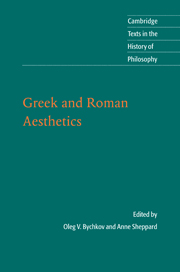Book contents
- Frontmatter
- Contents
- Preface
- Introduction
- Chronology
- Further reading
- Note on the texts and the translations
- Greek and Roman Aesthetics
- Gorgias
- Plato
- Xenophon
- Aristotle
- Philodemus
- Cicero
- Seneca
- Longinus
- Philostratus
- Philostratus the Younger
- Aristides Quintilianus
- Plotinus
- Augustine
- Proclus
- Index
- CAMBRIDGE TEXTS IN THE HISTORY OF PHILOSOPHY
Seneca
Published online by Cambridge University Press: 05 June 2012
- Frontmatter
- Contents
- Preface
- Introduction
- Chronology
- Further reading
- Note on the texts and the translations
- Greek and Roman Aesthetics
- Gorgias
- Plato
- Xenophon
- Aristotle
- Philodemus
- Cicero
- Seneca
- Longinus
- Philostratus
- Philostratus the Younger
- Aristides Quintilianus
- Plotinus
- Augustine
- Proclus
- Index
- CAMBRIDGE TEXTS IN THE HISTORY OF PHILOSOPHY
Summary
Letters or Lucilius
Letter 65.2–10
As you know, our own Stoics proclaim that there are two principles in nature that are responsible for the existence of everything: cause and matter. Matter is something inert in the state of rest, ready to become anything, which would remain idle if nothing moved it. At the same time, cause, or reason, shapes matter and moulds it into whatever it wishes, producing various things out of it. Therefore there must be the material out of which something is produced, and then the agent of production: the former is the matter, the latter is the cause. All art consists in imitation of nature; therefore apply what I said about the world in general to human products. Thus in the case of a statue, there is both matter that is subject to the activity of the artist, and the artist who gives external shape to matter. In a statue bronze is the matter and the sculptor is the cause. All things share the same condition: they consist of that which becomes and of that which produces.
The Stoics believe there is one kind of cause: that which produces. Aristotle thinks that ‘cause’ is predicated in three different ways: ‘the first cause’, he says, ‘is the matter itself, without which nothing can be produced; the second is the producer; the third is the form, which is impressed on every product, as on a statue’. That last one Aristotle calls eidos (form, shape).
- Type
- Chapter
- Information
- Greek and Roman Aesthetics , pp. 141 - 146Publisher: Cambridge University PressPrint publication year: 2010

